11/21/2006: Daisy
 Daisy is a flower, wellknown and loved by kids.
This little flower colours the meadows with white and yellow dots.
Daisy is a flower, wellknown and loved by kids.
This little flower colours the meadows with white and yellow dots.
Modern phytotherapy doesn't use the Daisy as a remedial herb, but countryside people love to use the Daisy for a lot of purposes.
A tea made from the leaves of the daisy strengthens the appetite and the metabolism. It stimulates the digestion and can also allay coughs. With its diureting effects daisy tea can help against swollen feet. Externally used the Daisy can help against rashes and wounds.
11/18/2006: Vermouth
 Vermouth is a typical plant for mediterranean countries.
In Central Europe Vermouth is cultivated in gardens,
like the monks showed in the middle ages.
Vermouth is a typical plant for mediterranean countries.
In Central Europe Vermouth is cultivated in gardens,
like the monks showed in the middle ages.
The bitter taste of the Vermouth makes it a famous bitter-herb against problems of the digestive system.
11/14/2006: Wild Mustard
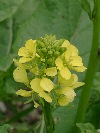 The Wild Mustard is a wild kind of mustard.
Where it grows, the farmers think of it as a nasty weed.
Its rough hairs distinguish it from other plants of the mustard family with yellow flowers.
The Wild Mustard is a wild kind of mustard.
Where it grows, the farmers think of it as a nasty weed.
Its rough hairs distinguish it from other plants of the mustard family with yellow flowers.
The seeds of the Wild Mustard can be used like the seed of cultivated Mustard. You can use it as a spice. With pulverized seeds you can make a poultice to tease the skin. This is strengthening the blood circulation.
Wild Mustard is also used as the Bach Flower Remedy Mustard.
11/06/2006: Heather
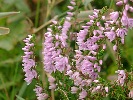 Heather grows in meager areas, where you sometimes can find lots of Heather like a carpet.
In late summer or autumn Heather can dye the whole area in violett.
Heather grows in meager areas, where you sometimes can find lots of Heather like a carpet.
In late summer or autumn Heather can dye the whole area in violett.
If you want to use Heather against rheumatism you need to take a bath with the Heather flowers. It is also used against eczemas.
10/30/2006: Borage
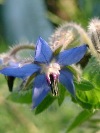 Borage is cultivated in gardens quite often as a spice for salads.
The hairy leaves look rather rough
but the beautiful blue flowers look very friendly.
Borage is cultivated in gardens quite often as a spice for salads.
The hairy leaves look rather rough
but the beautiful blue flowers look very friendly.
The taste of the Borage fits very good to cucumbers and salads.
As a herbal remedy Borage is used to treat nervous heart problems and depression.
10/25/2006: Oak
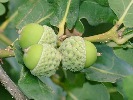 In Germany the Oak tree is the king of the trees.
One reason for this is the durable wood and the long life oth the Oak.
In Germany the Oak tree is the king of the trees.
One reason for this is the durable wood and the long life oth the Oak.
The acorns that ripen in autumn taste bitter, but through washing very intensive the bitter essences disapear and the dried acorns can be used as flower what helped a lot in hungry times. The acorns can also be used as coffee substitute.
The bark of the young branches of the Oak are very astringent, what makes them a good remedy against bleeding and inflammation. It is mainly used externally as a bath or a poultice.
10/12/2006: Aunt Ickes Rowan Berry Jam
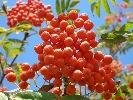 This delicious recipe of a Rowan Berry marmelade comes from my greataunt Icke,
who was happy having this tasty but cheap jam, when times where bad.
This delicious recipe of a Rowan Berry marmelade comes from my greataunt Icke,
who was happy having this tasty but cheap jam, when times where bad.
My mother kept this recipe and told me already in my childhood, that Rowan Berries are not as poisonous as other people believe. We ate a lot of aunt Ickes Rowan Berry marmelade when we where childs.
This harsh but sweet marmelade consists of stewed Rowan Berries, apple pulp and caramelized sugar.
10/10/2006: Rowan Berry
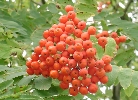 Most people believe, that Rowan Berries are poisonous.
That is good for those, who know, that cooked Rowan Berries are not poisonous
and that marmelade made of them is very delicious,
because they can find lots of Rowan Berries that nobody wants to harvest (exept birds).
Most people believe, that Rowan Berries are poisonous.
That is good for those, who know, that cooked Rowan Berries are not poisonous
and that marmelade made of them is very delicious,
because they can find lots of Rowan Berries that nobody wants to harvest (exept birds).
Rowan Berries have healing effects on the digestion, the liver and the lung. This is a secret, that is unknown even by the Rowan Berry marmelade fans.
10/8/2006: Report: 10/07: Autumn
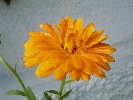 Now it is autumn for the herb container as well.
It is still rather green, even better than in the heat of july,
when the plants looked quite miserable.
Though I could harvest several marigold blossoms and seeds
and I could cook with the thyme and majoram
I am not really content with the herb container experiment.
Now it is autumn for the herb container as well.
It is still rather green, even better than in the heat of july,
when the plants looked quite miserable.
Though I could harvest several marigold blossoms and seeds
and I could cook with the thyme and majoram
I am not really content with the herb container experiment.
I also wrote about some other episodes of the herb-container and the first little harvest with the preparation of a Marigold Thyme Majoram Cream
10/7/2006: Essential Oils - Aromatherapy
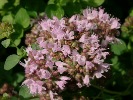 In aromatherapy the fragrance of essential oils are used for healing.
In aromatherapy the fragrance of essential oils are used for healing.
The fragrance of essential oils doesn't only have an influence on the body but on the soul also.
We have prepared the most important essential oils with their main uses for you.
10/6/2006: Kombucha
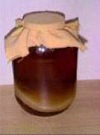 The drink that is prepared with the Kombucha culture
has a strong activating effect on the metabolism of the human body
and is said to clean the blood.
The drink that is prepared with the Kombucha culture
has a strong activating effect on the metabolism of the human body
and is said to clean the blood.
Therefore it is taken as a universal remedy by a lot of people. Some people believe, Kombucha could help to cure cancer and some think it may prolong life.
10/4/2006: Willow
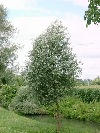 The Willow is a wide-spreaded tree that likes to grow beside water.
The main ingedrient of the Willow is Salicine that is converted to Salicylic acid inside the human body.
Salicylic acid helps against pain, fever and allies inflammation.
The Willow is a wide-spreaded tree that likes to grow beside water.
The main ingedrient of the Willow is Salicine that is converted to Salicylic acid inside the human body.
Salicylic acid helps against pain, fever and allies inflammation.
Salicylic acid is used in modern pain medicines. In former times people drank Willow tea if they suffered from pain or fever.
9/5/2006: Hops
 You may know the hop from the bitter taste of beer.
It helps to make the beer calming to the nervous system.
You may know the hop from the bitter taste of beer.
It helps to make the beer calming to the nervous system.
Hop is a climbing plant that has female flowers looking like a little, green fir-cone. This females flowers are the parts that are used of the hop.
Where hop ist cultivated, the plants grow up to seven meters on special frames, year by year because the parts above the earth die in wintertime and grow again in the next year.
8/31/2006: Watercress
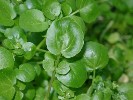 The Watercress is growing in and at rivers and seas.
It doesn't only grow in summertime but also in the winter.
Therefor you can find it in early spring and late autumn
and enjoy the lots of vitamins, that the watercress is providing.
The Watercress is growing in and at rivers and seas.
It doesn't only grow in summertime but also in the winter.
Therefor you can find it in early spring and late autumn
and enjoy the lots of vitamins, that the watercress is providing.
Its thick leaves look rather juicy, what shows that it can be used in salads. Salads and herbal fresh cheese are the main ways to use the watercress.
Used in this way it can help against spring tiredness and lack of vitamins.
8/30/2006: Bryony
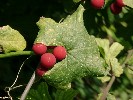 Bryony is a poisonous herb, that is climbing up to four meters.
Out of greenish-white little flowers red berries develop in late summer.
The root can become really big, it is like a rape.
In former times it was used against rheumatism.
Bryony is a poisonous herb, that is climbing up to four meters.
Out of greenish-white little flowers red berries develop in late summer.
The root can become really big, it is like a rape.
In former times it was used against rheumatism.
But as the whole plant is poisonous, it is only used in homeopathic doses in our days. Like this it can help against rheumatism, problems of the respiratoy system and pain in the muscles and joints.
7/25/2006: Butterweed
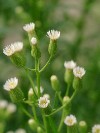 The Butterweed is a plant that is about one meter (three feet) high.
Originally it is at home in northern America.
Since the 17th century it has spread around the world, especially in Europe.
The Butterweed is a plant that is about one meter (three feet) high.
Originally it is at home in northern America.
Since the 17th century it has spread around the world, especially in Europe.
The flowers of the Butterweed are very small, therefore they are not seen as beautiful. Inspite of its size the Butterweed is noticed very seldom.
The Butterweed can help against diarrhea and bleedings. You can also use it against problems of women.
7/14/2006: St Johns Wort
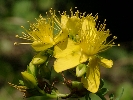 St Johns Wort is the most famous midsummer plant.
Even its name comes from the holy John,
the namegiving saint of the 24th of june.
St Johns Wort is the most famous midsummer plant.
Even its name comes from the holy John,
the namegiving saint of the 24th of june.
In the days around midsummer the St Johns Wort opens its yellow flowers. It stands beside roads, in sunny clearings, at embankments and other sunny places.
The St Johns Wort is associated with the sunlight and warmth of the summer. It absorbes the light of the sun at the longest days of the year, to release it in the dark wintertime when using the St Johns Wort as tea or tincture.
St Johns Wort can bring warming sunlight to depressive minds. That was already known by Paracelsus in the middle ages. In our days scientists have found out that St Johns Wort really helps against depression.
4/20/2006: Coltsfoot
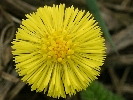 The Coltsfoot can grow on very poor soil, even on brown coal,
where it is the only plant to grow.
The Coltsfoot can grow on very poor soil, even on brown coal,
where it is the only plant to grow.
In early springtime it is one of the first flowers that blossoms. The soft leaves appear one month later, when the flowers finished blossoming. The leaves smell like mild balsam and are grey and feltlike at the bottom side.
The main use of the Coltsfoot are problems of the breathing system. It can help against cough, bronchitis and asthma.
4/8/2006: Flower Essences: Chickweed Essence
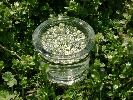 Chickweed symbolizes staying power,
obstinacy and self-confidence.
Chickweed symbolizes staying power,
obstinacy and self-confidence.
It can help us to keep our courage even in difficult situations and to stay on our way of life. Therefore we can dedicate ourself to our mission in life.
Even invectives don't disturb us, and we can trust our own judgement.
4/5/2006: Report: 04/04: Growing
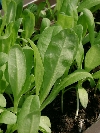 The plants in the herb-container are growing nicely
and develop how I wanted.
The plants in the herb-container are growing nicely
and develop how I wanted.
In the daytime the herbs are brought outside to enjoy the sun that is becoming lighter and warmer.
They also like the wind. The wind is making the plants stronger.
4/1/2006: Chickweed
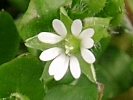 Most garden owners know Chickweed as a weed in their garden.
But Chickweed is a vegetable and salad, that is cultivating on their own
and it helps to protect the naked soil in the garden like a living mulch.
Most garden owners know Chickweed as a weed in their garden.
But Chickweed is a vegetable and salad, that is cultivating on their own
and it helps to protect the naked soil in the garden like a living mulch.
All over the year you can collect the Chickweed and prepare salads, soups and herbal quark. These meals stimulates the digestion and the metabolism.
Chickweed also helps against lots of skin problems. You can try it against psoriasis and itching eczemas.
3/22/2006: Pileworth
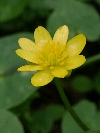 Often the Pileworth is the first green plant of the year that grows in sunny forrests.
The leaves of the Pileworth sometimes build big carpets of green.
Often the Pileworth is the first green plant of the year that grows in sunny forrests.
The leaves of the Pileworth sometimes build big carpets of green.
After the green leaves yellow blossoms appear that add shining color to the carpet of leaves. But these blossoms also show, that the leaves are becoming poisonous.
Before the blossoms show up the leaves can be eaten in salads. They help against spring tiredness.
3/16/2006: Selfmade Flower Essences
 Beside the Bach Flower Remedies to buy,
you can make your own Flower Essences by yourself.
This could be the typical plants of the Bach flower essences
or you can take other plants as well.
Beside the Bach Flower Remedies to buy,
you can make your own Flower Essences by yourself.
This could be the typical plants of the Bach flower essences
or you can take other plants as well.
To prepare your own Flower Essences is a lot of fun and you come in close contact to the essences.
3/13/2006: Report: 13/03: Sprouting
 The herbs are diligently sprouting.
The herbs are diligently sprouting.
There are still new sprouts every day but I guess the most plants are already growing in the light.
The marigold-plants already have long "ears" and some of them show their third leave.
3/12/2006: Chicory
 The blue flourishing Chicory grows beside roads and paths.
Most people don't even see this plant growing there, because it is quite airy.
The blue flourishing Chicory grows beside roads and paths.
Most people don't even see this plant growing there, because it is quite airy.
In ancient times and in the middle ages the Chicory was famous as a magical herb. It was very valuable because of this.
Today the Chicory is used to strengthen the digestion and you can make a coffee substitute from the roots.
Chicory is one of the Bach flower essences also.
3/9/2006: Heartsease
 Heartsease is wide spreaded in our gardens and flower-bed along streets.
Gardeners like it to bring colors to their gardens in springtime and autumn.
Heartsease is wide spreaded in our gardens and flower-bed along streets.
Gardeners like it to bring colors to their gardens in springtime and autumn.
Only few people know, that there is also a wild kind of heartsease, that is rather seldom.
The wild heartsease is a powerful remedial herb, that is specially good for children because it is mild. Heartsease helps against cough, problems of the urinary system, a sensible nervous system and a lot of skin problemes.
3/4/2006: Norway Spruce
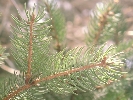 The spruce is a wide-spread tree, that lives in boreal and temperate regions.
Very often it is cultivated because of its wood.
The spruce is a wide-spread tree, that lives in boreal and temperate regions.
Very often it is cultivated because of its wood.
The soft young shoots, that can be recognized from their lighter color, can be used as a herbal remedy.
The main uses of the spruce are problems with the respiratory system, because the essential oils of the spruce desinfect and clean the lung.
Another use of the spruce are problems with the blood supply.
3/1/2006: Marigold Lanolin Cream
 The Marigold Lanolin Cream contains Marigold Oil
and Marigold Tincture.
That gives a duble marigold-power to this cream.
The Marigold Lanolin Cream contains Marigold Oil
and Marigold Tincture.
That gives a duble marigold-power to this cream.
You can use it against skin illnesses, ulcers, contusions, wounds that heal badly, eczemas, bruises, effusion of blood, strain or sore baby skin.
This cream is rather greasy and has an aroma of beeswax.
2/28/2006: Avens
 Avens is a plain plant with small yellow flowers.
Where it grows, in light forests or near old wall
you can usually find a lot of them.
But only few people know the avens in our days.
Avens is a plain plant with small yellow flowers.
Where it grows, in light forests or near old wall
you can usually find a lot of them.
But only few people know the avens in our days.
In former times avens was a very important remedial herb and spice. It was cultivated in the most gardens.
The root of the avens smells and tastes like clove. Therefore it what used as a substitute for clove.
You can use the root of the avens against diarrhea and other problems of the digestion. It also helps against inflammations of the mouth.
2/28/2006: Cough Tincture
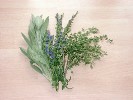 The cough tincture is made of Thyme, Sage and Hyssop.
The cough tincture is made of Thyme, Sage and Hyssop.
The combination of thyme, sage and hyssop is not only good against cough but also has other possible uses.
For example: soar throat, gingivitis, digestive problems, too much sweating, meteorism and weak menses.
Externally you can use it against skin inflammations, wounds and insect stings.
You can also find a new basic recipe for tinctures.
2/27/2006: Search
We set up a search for searching the Remedial Herbs website.
2/26/2006: Report: 2/26: Light
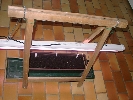 Because of the early germing I am in difficult situation,
specially because winter came back and outside it is very cold and grey.
Because of the early germing I am in difficult situation,
specially because winter came back and outside it is very cold and grey.
The problem is, that I don't have a sunny windowsill. I wanted to grow the herbs outside in the garden to give them enough light. But now it is much to cold for the small sprouts.
What to do?
2/25/2006: Snowdrop
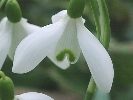 When the snowdrop blossoms the winter is finally over.
When the snowdrop blossoms the winter is finally over.
Nearly everybody knows this happy message of the fragile white snowdrop.
But only few people know, that the snowdrop ist a herbal remedy as well. Even in old herbal books you will not find the snowdrop.
The bulb of the snowdrop can help to slow down alzheimer's disease and it also helps against poliomyelitis and neuralgia.
2/24/2006: Report: 2/24: First Germ
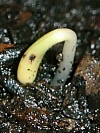 Suprisingly the first germ showed up today.
Suprisingly the first germ showed up today.
I think it will be a marigold plant.
The place is between the marigold and the majoram seeds but the germ is to thick for a majoram. Therefore I believe it will be a marigold.
I am very happy about this early seedling.
2/22/2006: Report: Herb container garden
 The report about the herb container garden is an instruction with images
how to grow your own herbs in a small container.
The report about the herb container garden is an instruction with images
how to grow your own herbs in a small container.
Whoever wants can share this gardening-experience.
We focused on the idea that this herb gardening should be really simple and doesn't need expensive equipment. The seeds should be available everywhere where you can buy seeds. You need a balcony or a window-sill, because such a small container doesn't need much place.
With this report we will accompany the development of the herb container garden from spring til autumn.
2/16/2006: Lanolin Cream and Rescue Remedy Lanolin Cream
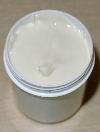 Now you can find a basic recipe that shows you how to prepare a cream
with lanolin anhydrous as emulsifier.
Now you can find a basic recipe that shows you how to prepare a cream
with lanolin anhydrous as emulsifier.
The cream gets rather fatty and a bit sticky. This type of cream is not so good for face creams but very good for medical creams.
There is also a recipe for a Rescue Remedy Lanolin Cream.
2/16/2006: Rescue Remedy creams
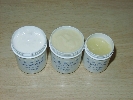 Sometimes you want to use the Rescue Remedies externally.
This is a good idea if you have hurt yourself or if your muscles have spasms.
Using the rescue remedies externally is also useful if someone can't swallow the rescue remedies.
Sometimes you want to use the Rescue Remedies externally.
This is a good idea if you have hurt yourself or if your muscles have spasms.
Using the rescue remedies externally is also useful if someone can't swallow the rescue remedies.
For the external use of the rescue remedies a cream or ointment ist very comfortable. You could mix the rescue remedies in every kind of ready made cream but it is very nice to make the rescue remedy cream by yourself.
Therefore you can find some recipes for rescue remedy ointments and creams. We start with an ointment.
2/15/2006: Mistletoe
 The mistletoe is a very strange plant, that you can see only in wintertime,
when the trees, where the mistletoes grow, lost their leaves.
The mistletoe is a very strange plant, that you can see only in wintertime,
when the trees, where the mistletoes grow, lost their leaves.
It grows in the form of balls on different kind of trees where it sucks water and minerals, what makes it a partial parasite.
In former times the mistletoe was a very important magical plant.
In modern herbal medicine the mistletoe is used against high blood pressure and against cancer. But it has much more uses.
2/11/2006: Bear Balm
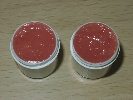 The balm of the tiger is known worldwide and helps for a lot of complaints.
The balm of the tiger is known worldwide and helps for a lot of complaints.
But I asked myself whether it is possible to make a similar balm out of herbs and essential oils that grow in Europe and North America. I had this idea because I love to use herbs that grow where I live.
The power animal of this western balm should be the bear, I thought, because the bear has a strong connection to Europe and North America. And the bear is really a powerful animal to allay lots of complaints. ;-)
Therefore the balm ist called: Bear Balm.
2/10/2006: Sage
 Sage is a typical mediterranian herb, but it grows very well in the middle of Europa also.
Sage is a typical mediterranian herb, but it grows very well in the middle of Europa also.
In the garden, at the right place, it can spread over several square meters.
Its specialty in the herbal medicine are its adstringend und desinfectant effects. Therefore it ist the first herb against sore throat.
The sage also stops sweating if someone is sweating too much.
When you look closer to the effects of the sage, you will find out, that it can help against a lot of complaints.
2/8/2006: Mint Balm
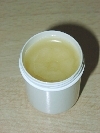 The Mint Balm is a rather hard kind of ointment with a lot of mint oil.
The Mint Balm is a rather hard kind of ointment with a lot of mint oil.
You can apply it on hurting parts of the body.
It helps against: Headache (applied on forehead and temples), Nervous pain, Sciatica, Lumbago, Rheumatic pain, Muscle spasms.
Applied on breast and back the mint balm can help against a cough.
2/7/2006: Peppermint
 Nearly everybody knows the Peppermint from refreshing herb teas,
that are drunken even if one is healthy.
Nearly everybody knows the Peppermint from refreshing herb teas,
that are drunken even if one is healthy.
But the Peppermint is a strong herbal remedy as well.
It strengthen the digestion and can allay nervous pains.
The Peppermint is easy to grow in gardens and as it is perennial it grows again year by year.
Other kinds of mint work similar to the peppermint.
2/5/2006: Comfrey Ointment
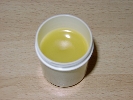 There is a new recipe for a comfrey ointment.
There is a new recipe for a comfrey ointment.
It consists of comfrey oil an beeswax as thickener.
The comfrey ointment can help against problems of the legs, arms and skin.
2/5/2006: Marigold Ointment
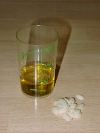 We opened an new area with recipes for preparing ointments and creams.
We opened an new area with recipes for preparing ointments and creams.
The first recipe is a marigold ointment. You can also find information about ingredients and equipment.
Go to the ointments-area...
2/4/2006: Foxglove
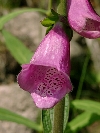 The flowers of the Foxglove are so flashy, that everyone who has seen a Foxglove will remember it.
The flowers of the Foxglove are so flashy, that everyone who has seen a Foxglove will remember it.
Usually you can see it in gardens because it is very beautiful, but sometimes you can find it wild growing in sunny places of forrests.
The Foxglove is very poisonous but as it is a strong remedy for weak hearts it is used very often by the medicine to strengthen the heart.
In the natural medicine the Foxglove isn't used because it is too dangerous. But you could use it as a homeopathic remedy.
2/2/2006: Horse Chestnut
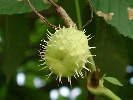 The Horse Chestnut is a big tree that grows in parcs and at roads.
Its size makes the Chestnut play a dominant role.
The Horse Chestnut is a big tree that grows in parcs and at roads.
Its size makes the Chestnut play a dominant role.
Kids know very well where Chestnut-trees grow because they can find the shining brown seeds in autumn to construct figures out of them.
Chestnuts have a lot of medical uses. To strengthen the veins ist the most wellknown use of them. Therefore you can use the Chestnut against varicose veins, haemorrhoids and Phlebitis.
1/25/2006: Comfrey
 The comfrey is a fast growing plant that gets long leaves already early in spring.
It loves to grow at humid places.
The comfrey is a fast growing plant that gets long leaves already early in spring.
It loves to grow at humid places.
Comfrey is the best herbal remedy against problems with the bones. It can help broken bones to heal.
It is also very good for skin problems.
You can prepare an ointment from the root of the comfrey to apply on sick areas.
1/24/2006: Herbal oil (hot)
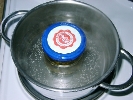 Herbal oils are herbs infused (macerated) in vegetable oil.
Herbal oils are herbs infused (macerated) in vegetable oil.
These infused oils are useful for treating the skin. Or you can use macerated oil for ointments, salves and creams.
This is a description how to make herbal oil with the hot method, with heating oil and herbs. It is good for roots or other hard parts of plants. You can use it also when you are in a hurry with your herbal oil.
We prepared comfrey oil as an example.
1/24/2006: Marigold
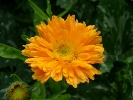 The marigold is not only a herbal remedy but is also a very nice flower in gardens.
From june on lots of farmers gardens in europe are shining from the brightness of the marigold.
The marigold is not only a herbal remedy but is also a very nice flower in gardens.
From june on lots of farmers gardens in europe are shining from the brightness of the marigold.
The flowers of the marigold are a good remedy against skin problems. Therefore the marigold ointment is famous.
1/23/2006: Herbal oil (cold)
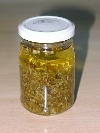 Herbal oils are herbs infused (macerated) in vegetable oil.
Herbal oils are herbs infused (macerated) in vegetable oil.
These infused oils are useful for treating the skin. Or you can use macerated oil for ointments, salves and creams.
This is a description how to make herbal oil with the cold method, without heating oil and herbs. It is good for fragile herbs or parts of herbs like flowers.
We prepared marigold oil as an example.
1/22/2006: Hollyhock / Garden mallow
 In european gardens you can see the Hollyhock very often
because of its beautiful flowers.
The plant grows taller than a man and carries huge red flowers along its stem.
In european gardens you can see the Hollyhock very often
because of its beautiful flowers.
The plant grows taller than a man and carries huge red flowers along its stem.
Like its relatives from the mallow family the Hollyhock helps against cough and other problems of the respiratory organs.
It is also helpful for skin problems.
1/21/2006: Cold Infusions
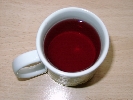 Cold Infusions are good for delicate herbs, that lose their quality when heated.
These are flowers or some soft roots, especially roots, that contain mucus.
Cold Infusions are good for delicate herbs, that lose their quality when heated.
These are flowers or some soft roots, especially roots, that contain mucus.
Also mistletoe is prepared as a cold infusion, because in cold wter the poison of the mistletoe doesn't dissolve.
1/20/2006: Inhalation
 You can do an inhalation with hot tea of herbs.
You can do an inhalation with hot tea of herbs.
Inhalations are good to let the substances of the herbs into your breathing system like sinuses, bronchi and lungs. Because of the humid steam it can help breathing.
It is also good to clean the skin of the face, espacially if you suffer from acne.
1/18/2006: Chamomile
 The Chamomile is maybe the most famous herb in the northern hemisphere.
Lots of grandmas allways use Chamomile, when somebody is ill,
and most of the times they are right with their treatment.
The Chamomile is maybe the most famous herb in the northern hemisphere.
Lots of grandmas allways use Chamomile, when somebody is ill,
and most of the times they are right with their treatment.
The medicinal uses of the Chamomile are very numerous. It can help in nearly every case of rather harmless sickness.
The wild growing Chamomile has become very seldom because the farmers don't like it in their fields and destroy it therefore. But the Chamomile is grown by special herb-farmers, because millions of people want to buy it day by day in pharmacies and supermarkets.
Nearly everybody knows the special smell of Chamomile, that is associated with health treatment.
1/17/2006: Decoctions (tea)
A decoction is useful when you want to make a tea out of hard parts of herbs, like root, bark or wood.1/15/2006: Infusion (tea)
An infusion is the most popular way to cook a tea of remedial herbs.For a hot infusion you pour boiling water on the herbs.
Infusions are good for normal herbs, the green parts of herbs and mixtures of different herbs.
1/14/2006: Blackthorn
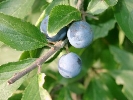 When walking in an european landscape you often see blackthorn-shrubs.
In spring time you can see thousands of white flowers,
that cover all the shrub.
When walking in an european landscape you often see blackthorn-shrubs.
In spring time you can see thousands of white flowers,
that cover all the shrub.
The fruits of the blackthorn are blue like plums but much smaller. Before frost comes, the fruit tastes harsh. After some frosty days the fruit become sweeter.
Blackthorn helps against problems of the digestion.
1/12/2006: Remedial Herbs Forum
A lot of questions about herbs reach me and as I don't have enough time to answer a lot of personal messages, I thought, it would be a good idea to open a forum.There, everybody can write, read and answer questions about herbs and their usage.
To the forum...
1/11/2006: Substances in remedial Herbs
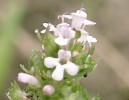 Remedial herbs contain a lot of substances.
Remedial herbs contain a lot of substances.
There are some kinds of substances, that are found in lots of herbs an lots of special substances, that can be found only in few herbs.
Here you find an overview of frequent substances and how they work.
1/10/2006: Juniper bush
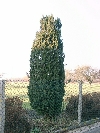 The juniper bush grows in many gardens, because it is very beautiful
and green in summer and wintertime.
The juniper bush grows in many gardens, because it is very beautiful
and green in summer and wintertime.
In former times juniper bushes where grown because they can heal a lot of diseases. In our days this reason for growing juniper bushes is nearly forgotten.
But it would be a good idea to keep a juniper bush in the garden, to have ones own pharmacy near the home, because juniper is good against a lot of health problems.
It activates the digestion, helps the kidneys and clears the lungs for good breathing. Also it kill bacterias, which is good against infections.
1/7/2006: Cinnamon
 When imagining cinnamon you think on cookies baked for christmas time.
Cinnamon is an exotic spice that reminds on far away southering countries and cosy wintertime.
When imagining cinnamon you think on cookies baked for christmas time.
Cinnamon is an exotic spice that reminds on far away southering countries and cosy wintertime.
In former times cinnamon was very expensive and only rich people could afford it. In our times nearly everybody can buy cinnamon for a good price.
But only few people know, that cinnamon is not only tasty but a very potential remedial herb.
Nearly every kind of illness can be treated with cinnamon.
In the last years cinnamon became famous for its ability to decrease the blood sugar level. Therefore it can help to treat diabetes.
12/12/2005: 100 new Herbs
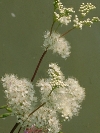 We collected hundred additional herbs
for the herbs-lexicon.
We collected hundred additional herbs
for the herbs-lexicon.
For example there are:
12/9/2005: Cranberry
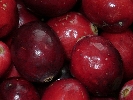 Cranberries are famous to be served with turkey on Thanksgiving.
As a jelly they are delicious to eat.
Cranberries are famous to be served with turkey on Thanksgiving.
As a jelly they are delicious to eat.
But they are also a very healthy fruit. They can cure bladder problems and problems with the metabolism.
Cranberries are healthy for the blood-vessels, they can help against arteriosclerosis and Angina pectoris.
Some people call the cranberries an remedy against ageing.
11/19/2005: Horseradish
 Horseradish is wellknown as a refinement of meat dishes.
Horseradish is wellknown as a refinement of meat dishes.
Only few people know, that it has strong remedial effects.
The sharp root of the horseradish helps against all kinds of infectious diseases and also against pain. The horseradish can even destroys viruses of the flu.
In the fall and winter, one should always have a horseradish root in the refrigerator or basement to have it available in case of a cold or a flu.
7/30/2005: Agrimony
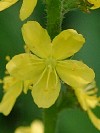 Already in acient times Agrimony was mentioned by Plinius and Dioskurides.
And in the middle ages Agrimony was a popular Remedy against problems
of the digestive and the urinary systeme.
Already in acient times Agrimony was mentioned by Plinius and Dioskurides.
And in the middle ages Agrimony was a popular Remedy against problems
of the digestive and the urinary systeme.
In our days Agrimony lost its popularity, but it is still used in teas for singers and speakers.
7/28/2005: Oregano
 To most of us, Oregano is known only as a spice for the pizza.
To most of us, Oregano is known only as a spice for the pizza.
Hardly anybody knows that the plant grows also in the wild nature and that it is also a medicinal plant.
7/26/2005: Clivers
 Most people know the clivers only form walks, where the little fruits stick to the cloths.
Most people know the clivers only form walks, where the little fruits stick to the cloths.
As a medicinal plant, it is rather unknown - unfairly, because it is a valuable remedy for our health, specially for the skin and the digestive system.
7/25/2005: Herb Robert
 The Herb Robert is a brother of the geranium
what is proved by the pretty but little blossoms.
Herb Robert smells rather harshly in contrast to the geranium.
In Germany it is called "stinking cranesbill" because of this smell.
The Herb Robert is a brother of the geranium
what is proved by the pretty but little blossoms.
Herb Robert smells rather harshly in contrast to the geranium.
In Germany it is called "stinking cranesbill" because of this smell.
In medicine, the Herb Robert helps us with problems of the skin and the digestive system.
7/23/2005: Lapacho
 The inner bark of the Lapacho tree was an allround remedy of the Incas.
Today local South Americans also use Lapacho against all kinds of diseases.
Not until in the second half of the twentieth century Lapacho was discovered
by the researchers and medical doctors of the occident.
In Europe, Lapacho is rather unknown, but in North America, it is a fashion remedy.
The inner bark of the Lapacho tree was an allround remedy of the Incas.
Today local South Americans also use Lapacho against all kinds of diseases.
Not until in the second half of the twentieth century Lapacho was discovered
by the researchers and medical doctors of the occident.
In Europe, Lapacho is rather unknown, but in North America, it is a fashion remedy.
7/22/2005: Blueberry
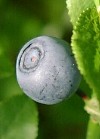 The blueberry grows in light forests and in the mountains.
It is a small bush, up to 50 cm high.
The blueberry grows in light forests and in the mountains.
It is a small bush, up to 50 cm high.
In the summer you can collect sweet blue fruit that are very delicate to eat.
You can just enjoy the blueberries or you can dry them and use them against diarrhea.
7/21/2005: Clubmoss
 Clubmoss is a moss that is growing in the mountains, in woods and on meadows.
In its club-like fruit stands, a fine spore powder that is well suitable against all kinds
of skin diseases as powder is growing.
Clubmoss is a moss that is growing in the mountains, in woods and on meadows.
In its club-like fruit stands, a fine spore powder that is well suitable against all kinds
of skin diseases as powder is growing.
But also for the urinary organs and for the metabolism Clubmoss spores offer their healing powers.
7/20/2005: Diseases
Now you can find more than 200 pages about diseases and herbs that can help against them.7/19/2005: Eyebright
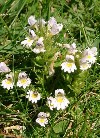 Eyebright is the traditional herb for curing problems of the eye.
Already our anchestors used it for this treatments.
Eyebright is the traditional herb for curing problems of the eye.
Already our anchestors used it for this treatments.
But Eyebright doesn't only help the eyes, it is also useful against a cold an digestion problems.
7/18/2005: Masterwort
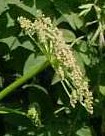 In the middle ages Masterwort was thought to be a remedy against every disease,
as we can easily see from the strong name.
The root was not only used for medicinal use but also for magical purposes.
But later the Masterwort was nearly forgotten.
In the middle ages Masterwort was thought to be a remedy against every disease,
as we can easily see from the strong name.
The root was not only used for medicinal use but also for magical purposes.
But later the Masterwort was nearly forgotten.
7/17/2005: Yellow Loosestrife
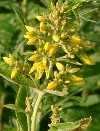 Few people know the Yellow Loosestrife but it is a favorable remedial herb
that can help in various medical problems.
Few people know the Yellow Loosestrife but it is a favorable remedial herb
that can help in various medical problems.
Its most outstanding capabilities are the adstringent an blood stopping abilities. That makes the Yellow Loosestrife a good remedy for gingivitis and bleeding of the gums.
7/16/2005: Welcome
 Welcome to the English version of the wellknown
German herbs-site heilkraeuter.net.
Welcome to the English version of the wellknown
German herbs-site heilkraeuter.net.
Now we start with the description of some herbs and bach flower remedies.
Step by step more herbs will follow with images.
Also recipies and additional infos are planed.
